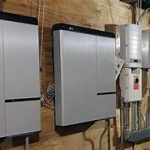Battery Storage for Your Solar PV System? Your Questions Answered
Reasons for Battery Storage
Let’s explore the reasons why you may want to include battery storage with your solar PV system. First of all, you don’t need battery storage to be able to operate your solar system when connected to the grid. When you generate more power than you need (e.g. sunny daytime when not at home), the excess power is exported to the utility grid where it becomes available to other grid customers. In Massachusetts, the utility pays you the same amount of money for that exported power as you pay when you draw from the grid. So your savings are not affected by whether or not you store the power in your home.
of all, you don’t need battery storage to be able to operate your solar system when connected to the grid. When you generate more power than you need (e.g. sunny daytime when not at home), the excess power is exported to the utility grid where it becomes available to other grid customers. In Massachusetts, the utility pays you the same amount of money for that exported power as you pay when you draw from the grid. So your savings are not affected by whether or not you store the power in your home.
The primary reason to have battery storage as part of your system in Massachusetts is the ability to keep your house powered during a blackout. Even if the sun is shining during a blackout, the solar system can not provide power to your home without a battery storage system.
The second advantage of having storage is that you can earn money from Eversource by allowing them  to use the stored energy in the battery during periods of high electrical demand on the grid (e.g. hot summer afternoon, cold winter day). Known as demand response, this interaction occurs without any intervention from you – it is enabled through your internet connection which allows Eversource to communicate with your battery storage controller. Demand response allows Eversource to use decentralized energy storage resources like batteries in homes and businesses to meet infrequent periods of peak demand. This reduces the need to construct more costly power plants or to call on expensive (and often very dirty) generation sources that are typically used only as a last resort in these peak demand situations.
to use the stored energy in the battery during periods of high electrical demand on the grid (e.g. hot summer afternoon, cold winter day). Known as demand response, this interaction occurs without any intervention from you – it is enabled through your internet connection which allows Eversource to communicate with your battery storage controller. Demand response allows Eversource to use decentralized energy storage resources like batteries in homes and businesses to meet infrequent periods of peak demand. This reduces the need to construct more costly power plants or to call on expensive (and often very dirty) generation sources that are typically used only as a last resort in these peak demand situations.
If you choose to take part in this program, you can earn roughly $1,000/yr, depending on the size of the battery storage system. Eversource will not initiate a demand response request when prevailing weather conditions indicate a possibility of adverse weather (because this is when you would need the standby power available in case of a blackout).
Battery System Availability
Battery storage systems are available from most solar companies. The large battery manufacturers include Tesla, Enphase, Sonnen, Generac, Panasonic, and LG. The batteries utilize Lithium Ion chemistry, similar to the batteries in your laptop computer or an electric vehicle. A newer version of the Lithium Ion chemistry (LiFePO4) has no potential for overheating/fire. But both chemistries have a long and safe track record when installed by trained contractors.
Battery System Cost
Battery storage can be expensive, depending on how much storage capacity you desire. Installed cost typically runs $1,000 – $1,500/KWH of storage capacity. In a house where you want to maintain power for 24 hours to supply your important 110v. loads (lights, refrigerator, TV, computer, furnace, etc.), you will probably need around 10-15 KWH of storage, with a cost of $15,000 – $25,000. Battery storage systems are eligible for the 26% Federal Tax Credit (as of 2021, the same as for a solar system), reducing the total cost to you. Zero interest loans for Battery Storage systems are available through the Mass Save Heat Loan Program (about 1/2 way down the page under “Financing Options”).
Fuel-power Generator Comparison
A fuel-powered generator with automatic transfer controls to serve as a backup system typically costs around $10,000. At first glance that may seem significantly less expensive than a battery storage.  But after you factor in the federal tax credit, savings from demand response and that fact that a battery system requires no maintenance, you will likely be close to breakeven between batteries and a generator. You can get real numbers for your particular application from your solar contractor. Also, Battery backup is “clean” and quiet compared to a generator. You can easily add battery storage to an existing solar system without costly modifications.
But after you factor in the federal tax credit, savings from demand response and that fact that a battery system requires no maintenance, you will likely be close to breakeven between batteries and a generator. You can get real numbers for your particular application from your solar contractor. Also, Battery backup is “clean” and quiet compared to a generator. You can easily add battery storage to an existing solar system without costly modifications.
Battery Life
The batteries are typically warranted for 10 years, but this does vary by manufacturer. The battery bank capacity typically declines over time as the batteries age (e.g. 70% storage capacity after 10 years).
Battery System Install Location
The battery bank should be installed indoors (e.g., basement, utility room, attached garage). Outdoor installations are not recommended unless there is no other option. In our climate, there is a loss of capacity during hot/cold conditions and the battery life is likely to be shortened. The space required for the battery varies by manufacturer, but using Tesla as an example, their single 13 KWH module is 4’H x 3’W x 6”D. Depending on the size of your house and the loads you want to carry on battery backup, you may need two modules. In this case, the second module is placed in front of the first for an overall depth of ~12”. The modules are very heavy and are typically mounted against a wall on a solid floor. Battery storage can be utilized in solar systems that have centralized inverters and systems using microinverters.
Shopping for a Battery System
When you shop around for a solar system, you should definitely ask for a cost/benefit analysis for adding storage. You may find that the convenience, reliability, and net-cost make it a “no-brainer.” You might want to look closely at the specifications of the battery systems that you are interested in — Tesla’s Powerwall spec sheet. is an example of what to look for/expect.

